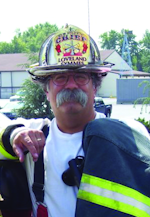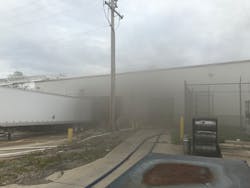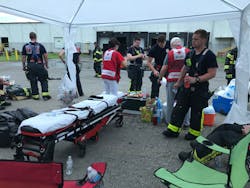Close Calls: Cold Smoke Showing from Big Box Fire
This month’s column was inspired by a call to which my department—Loveland-Symmes, OH, Fire Department (LSFD)—responded on May 29 as part of a first-alarm, automatic mutual-aid assignment. To be clear, this is not a first-hand look at the specific fire, with in-depth analysis of the play-by-play actions of the crews, as it is too soon for that, and there was not a specific “close call” moment. The only “injury” we had was a firefighter with a leg cramp; not bad for 90 degree weather, 90 percent humidity and about 75 firefighters operating over 8-plus hours. However, upon arriving and operating, we were all very seriously reminded about the risk and historic danger of a working fire within large-area buildings.
Setting the stage
We responded to a fire in a 270,000-square-foot building filled with class A (paper) and class B (plastics) materials. Upon arrival, several fire sprinkler heads had gone off and were keeping the fire in check, and the entire building was filled with cold smoke. The fire was burning deep in the center of the building, surrounded by these paper and plastics, and presenting access challenges for firefighters.
Departments in our area—the northeast suburbs of greater Cincinnati—have fully grasped the concept of sending a heavy response to structural fires, and we have an automatic-aid culture of which I am personally very proud. Among all our fire departments, we average about 25–30 firefighters on first-alarm verbal reports of a fire, and no one is shy to strike additional alarms.
We didn’t always have this approach, but through some excellent chiefs who “get it,” we now have an excellent box alarm first-alarm (and multiple-alarm) response culture that focuses on the needs of those having the fire—and the needs of the firefighters who will be fighting the fire. For those who haven't grasped the concept of cooperative firefighting that includes regular mutual, collaborative training starting immediately on the first alarm “without excuses,” we say try it; you'll like it. This particular fire received an appropriate first alarm that matched the risk and type of structure, along with five chief officers from area departments, including two deputy chiefs who functioned as the incident commander and aide/adviser. The fire went well, no one was seriously hurt, and plenty of property was saved. It was a very time-intensive fire (8 hours on scene) with a constant balance of getting a handle on the fire and not getting anyone seriously hurt over what was, quite frankly, piles of plastics pallets and papers on fire. Although I cannot yet provide the usual information about what went right and what we would do different because the fire just occurred, and the commanding officers have not yet had time to meet, conduct a post-incident analysis, collect feedback from all divisions, etc.; however, it was an excellent reminder of the factors to consider when operating at ANY of these high-risk/low-frequency fires—and that's what I want to share. After all, history has proven that these kinds of fires create close calls, firefighter injuries and firefighter deaths. Our collective goal—you, us, we, etc.—is to be well prepared and trained to minimize that potential, from well before the fire to on-scene operations.
Key considerations
Following discussions of big box/cold smoke fires with one of my fellow deputy chiefs at LSFD—our chief of operations, Josh Blum—along with others, I compiled a list of key considerations so that you too can do a refresher prior to your department’s next big box or cold smoke fire. These considerations can be used as a checklist to create discussion, generate thought and serve as training opportunities.
Size-up: Initial size-up may not be what you think or even see. The 360 on this type of building is not like the 360 at a dwelling fire.
Command and control: Command must develop and state a clear strategy and apply the required tactics by deploying firefighters who accomplish the task, immediately supervised by company officers and overseen by division supervisors. This works at every fire when we maintain discipline with strong command and control.
Access to the fire: Generally, the best tools to gain access to the fire (which may not always be the most direct, depending on conditions) are current preplans and building representatives. Although building reps may be there during business hours, access may be challenging after hours. That's why current contact information is so important. Often fire prevention personnel are responsible for maintaining this information, but it is incumbent on first-due companies to tour and visit these buildings as well. There is nothing like the feeling of "I know this place—we have done walk-throughs and preplanning here” when you arrive. As Frank Brannigan taught us for years, “The building is our enemy; know your enemy.”
Understanding cold smoke: I reached out to subject-matter expert Chief Dave Dodson (“The Art of Reading Smoke”) to describe cold smoke. Dodson uses the phrase “cold smoke” for smoke that has lost its velocity and is smooth flowing. (And as a reminder, velocity refers to the rapidity of motion, swiftness, speed and energy.) As he states: “A small volume of smoke from more than one location of a LARGE building could mean a LARGE fire deep within.”
Read the smoke: Crews need to read the smoke, both exterior and interior, by monitoring various areas/division—continually. Understand that cold smoke (or really any smoke!) is an integral part of the size-up, is extremely dangerous, and these conditions have a history of providing a false sense of security to members operating. Without the heat and “action” of an immediately identified fire, the cold smoke can falsely give an impression of this doesn't seem like much, which have led to tragic outcomes in the past. Building depth/layout/preplan: As noted, it is important to understand the building prior to the fire, or at the very least, prior to entry.
SCBA usage vs. interior travel depth: Consider that if it takes 15 minutes to get in and find the fire, you’re in trouble if you need more than 5 minutes to get out. Air management is top priority for the individual firefighter, the company officer/team leader/division supervisor and command. While always critical, these fires require no-nonsense discipline, control and leadership at every level. Air management: A bell ringing on an SCBA cannot ever be ignored on any fireground; it means you are overdue to leave and does not mean “please gimme just 5 more minutes.” In many areas today, the activation of the bell requires a RIT response to ensure safe exiting of the members.
Accountability: My boss, Chief Otto Huber, uses the phrase “Stay in your lane,” which means that we should do what we are expected to do and stay focused on our job and responsibilities. This, of course, requires discipline. So when you suspect a firefighter may be in trouble, stay focused on your role, be accountable for your actions, and make sure you are where you were told to be and doing what you are expected to do. Simply put, every division supervisor must know what their companies are doing, where and with whom and, of course, every company officer must have full knowledge of their personnel and related assignments. Accountability-related questions should never be met with the response, “I don't know.”
Wide-area search: A longtime friend, Deputy Chief (ret.) Skip Coleman of Toledo Fire Rescue in Ohio, and a noted subject-matter expert in large-area searches and related fires, shared some important insight: “In these smoke-filled environments, the understanding of time and air management is critical at each level (task, tactical and strategic) of the operation. Because we are looking at ‘large-area search,’ the term ‘large area’ should be a huge warning sign related to command, control and accountability within that task. Think about how long it will take you to search a school gym, factory, warehouse, large restaurant, small convention center or even a grocery store in IDLH (zero visibility) conditions. With a rope or not? The answer is too long!”
Locating the fire: Consider the above (wide-area search) in searching for the fire as well as victims. Going in and just “looking for it” may be your only option, but consider other options, like in-building security systems, on-scene management/maintenance, preplans, sprinkler heads flowing, etc. Once again, training “hands on” based upon your department’s policies and procedures with your first- and second-alarm companies (or more) is the best way to figure out as much as you can before the fire.
Thermal imagers: Thermal imagers are an essential tool for any crew operating at any fire, and certainly these fires due to the depth, cold smoke and fire access/time and distance.
Staffing: On-deck staffing, including rapid intervention, is a critical function and requires a plan. This is not a “run in and get them” environment and requires significant training and operational policy specific to large-area ops.
Assignments: Limit the number of personnel deployed for specific purposes. While everyone may want to “get in there,” it’s your fire. Just say no and, if needed, send the non-disciplined people home. Further, company officers must clearly understand their assignments and “stay in their lane,” focusing on their specific assignment.
Radio communications: Make sure you can count on excellent radio usage and performance in these large buildings. Test well prior to the fire so you know what may or may not work. And have a plan B in case things don’t work as intended.
Water supply: What is the water supply situation, both on site and off site (private vs. municipal water supply/reliability)?
Extinguishment: When it comes to getting water on the fire beyond the sprinklers, what’s the plan—large handlines, portable ground monitors, aerial devices?
Foam: Consider the use of the appropriate foam to compress the gases and smother the fire so ventilation is more effective. If doing so, how will that foam be applied? Consider portable ground monitors to flow the foam.
Ventilation: How do you plan to ventilate that large-area building? Hydraulic ventilation with portable ground monitors can be very effective. What are your other options?
Rest: Monitor the work/rest cycle in the division. Some may not want to leave or may want to work more. This is not the time for democracy. Ensure crewmembers do as ordered so as to not over-exert themselves and end up in a bad situation.
Perspective: Remember that when the occupants are fully accounted for and the fire is being contained by sprinklers and just needs to be overhauled or extinguished, your “emergency” is far less of an emergency.
Collapse potential: When the burning materials inside are on racks and they get wet, this creates collapse issues.
Egress: If you move interior “stuff,” such as stock, make sure there remains a means of egress for members operating inside.
Rehab: Everyone should report to rehab. Make sure everyone knows where that is and that it is properly staffed with medical- and refreshment-related resources.
Final thoughts
This is by no means a comprehensive training or operational lesson plan for these kinds of fires, but this does offer plenty of food for thought so that your members are as ready as possible when “that” building is reported on fire. The cold smoke large-area industrial fire is always a tough fire, and there is a significant history of firefighters getting lost in these fires. Take time to research and read about these fires from those who have experienced them, with both positive and tragic outcomes.
My sincere thanks to Mason, OH, Fire Chief Bryan Brumagen, Loveland-Symmes Fire Chief Otto Huber, Mason Deputy Chiefs Todd Day and Steve Botts, Deerfield Township Fire Chief Chris Eisele and Battalion Chief Mark Miller, and Loveland-Symmes Deputy Chief Josh Blum for their insight, experiences and thoughts related to these types of fires. These fire officers and others in our region live a constant and mutual focus on taking care of the public and our personnel using aggressive training, appropriate resources and best known and proven practices for the best possible outcomes.
Sidebar: Remembering Gramma GG
You may have noticed that this column is less in-depth than our normal first-hand look at a specific fire. The reason: I recently lost my mom at the age of 90 after a pretty tough, several-year battle with Alzheimer’s disease. But I will say this: If anyone ever “beat” that disease, she came damn close, as she laughed and sang (in her unique style) right up until her last conscious day, passing away several days later. While our family and friends grieve at her passing, we smile when thinking about her and all the laughter and love she always gave us. Her constant positive enthusiasm was impenetrable and infectious. Rest in peace, Mrs. G.

Billy Goldfeder
BILLY GOLDFEDER, EFO, who is a Firehouse contributing editor, has been a firefighter since 1973 and a chief officer since 1982. He is deputy fire chief of the Loveland-Symmes Fire Department in Ohio, which is an ISO Class 1, CPSE and CAAS-accredited department. Goldfeder has served on numerous NFPA and International Association of Fire Chiefs (IAFC) committees. He is on the board of directors of the IAFC Safety, Health and Survival Section and the National Fallen Firefighters Foundation.








